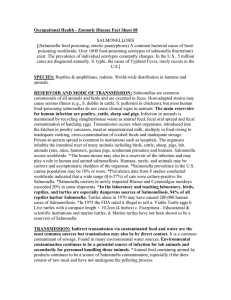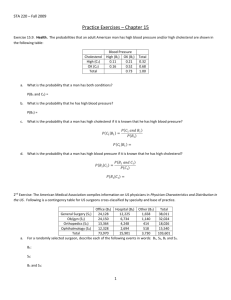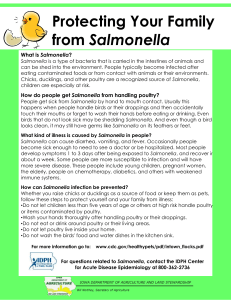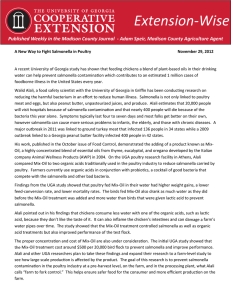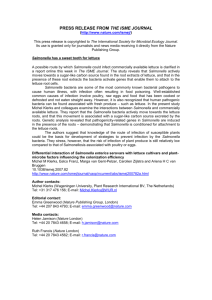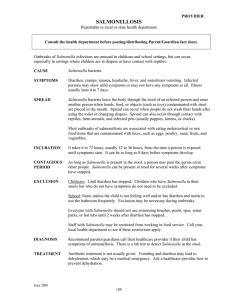Patient Information Leaflet
advertisement
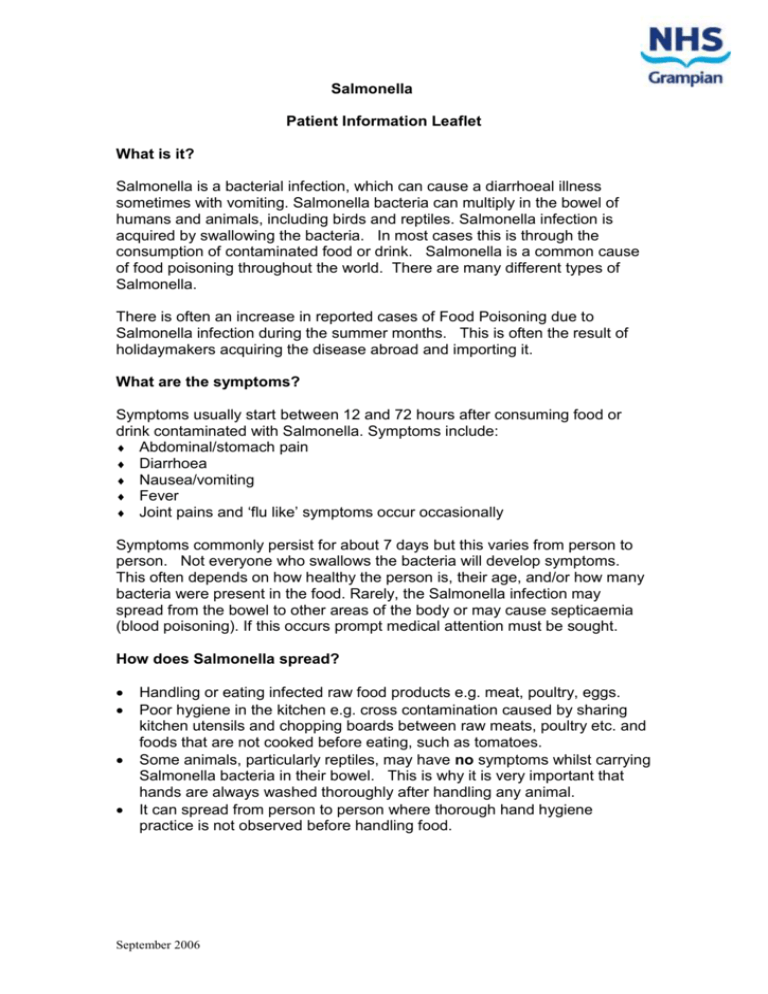
Salmonella Patient Information Leaflet What is it? Salmonella is a bacterial infection, which can cause a diarrhoeal illness sometimes with vomiting. Salmonella bacteria can multiply in the bowel of humans and animals, including birds and reptiles. Salmonella infection is acquired by swallowing the bacteria. In most cases this is through the consumption of contaminated food or drink. Salmonella is a common cause of food poisoning throughout the world. There are many different types of Salmonella. There is often an increase in reported cases of Food Poisoning due to Salmonella infection during the summer months. This is often the result of holidaymakers acquiring the disease abroad and importing it. What are the symptoms? Symptoms usually start between 12 and 72 hours after consuming food or drink contaminated with Salmonella. Symptoms include: Abdominal/stomach pain Diarrhoea Nausea/vomiting Fever Joint pains and ‘flu like’ symptoms occur occasionally Symptoms commonly persist for about 7 days but this varies from person to person. Not everyone who swallows the bacteria will develop symptoms. This often depends on how healthy the person is, their age, and/or how many bacteria were present in the food. Rarely, the Salmonella infection may spread from the bowel to other areas of the body or may cause septicaemia (blood poisoning). If this occurs prompt medical attention must be sought. How does Salmonella spread? Handling or eating infected raw food products e.g. meat, poultry, eggs. Poor hygiene in the kitchen e.g. cross contamination caused by sharing kitchen utensils and chopping boards between raw meats, poultry etc. and foods that are not cooked before eating, such as tomatoes. Some animals, particularly reptiles, may have no symptoms whilst carrying Salmonella bacteria in their bowel. This is why it is very important that hands are always washed thoroughly after handling any animal. It can spread from person to person where thorough hand hygiene practice is not observed before handling food. September 2006 What precautions do I have to take? 1. Thorough hand washing, taking care to clean the fingertips and between the fingers. Wash hands : 2. 3. 4. 5. 6. 7. 8. after and before handling raw meat cooking handling any animals handling food changing nappies eating visiting the toilet feeding the young or elderly outdoor working or leisure activities handling clothes which are dirty due to outdoor working or leisure activities Ensure all foods are thoroughly cooked. Do not use the same chopping board or kitchen surface or knife for raw meat or poultry and then for other foodstuffs without first washing it thoroughly to prevent cross contamination. Store poultry and meats in the fridge. Store cooked food at the top of the fridge and uncooked food at the bottom. Thoroughly wash all salad vegetables and fruit before consumption Do not drink unpasteurised (raw) milk or milk in bottles where the tops have been pecked by birds. Remove any clothing contaminated with animal faeces (e.g. wellington boots, overalls) and then wash your hands. Exclude pets and pests from food preparation areas. Will I need treatment? Generally people who have Salmonella do not require treatment other than making sure that they drink enough fluid to prevent dehydration. In severe cases, very young infants or where people are being excluded from work an appropriate antibiotic may be prescribed by your GP. If an antibiotic is prescribed, it is important that you complete the course as instructed on the bottle or packet. In most cases patients can return to work when they have been symptom free for 48 hours. Food businesses may have their own guidelines that exclude individuals for longer. If you need this or any other NHS Grampian publication in an alternative format (large print) or in another language please contact the Health Protection Team on 01224 558520 September 2006


